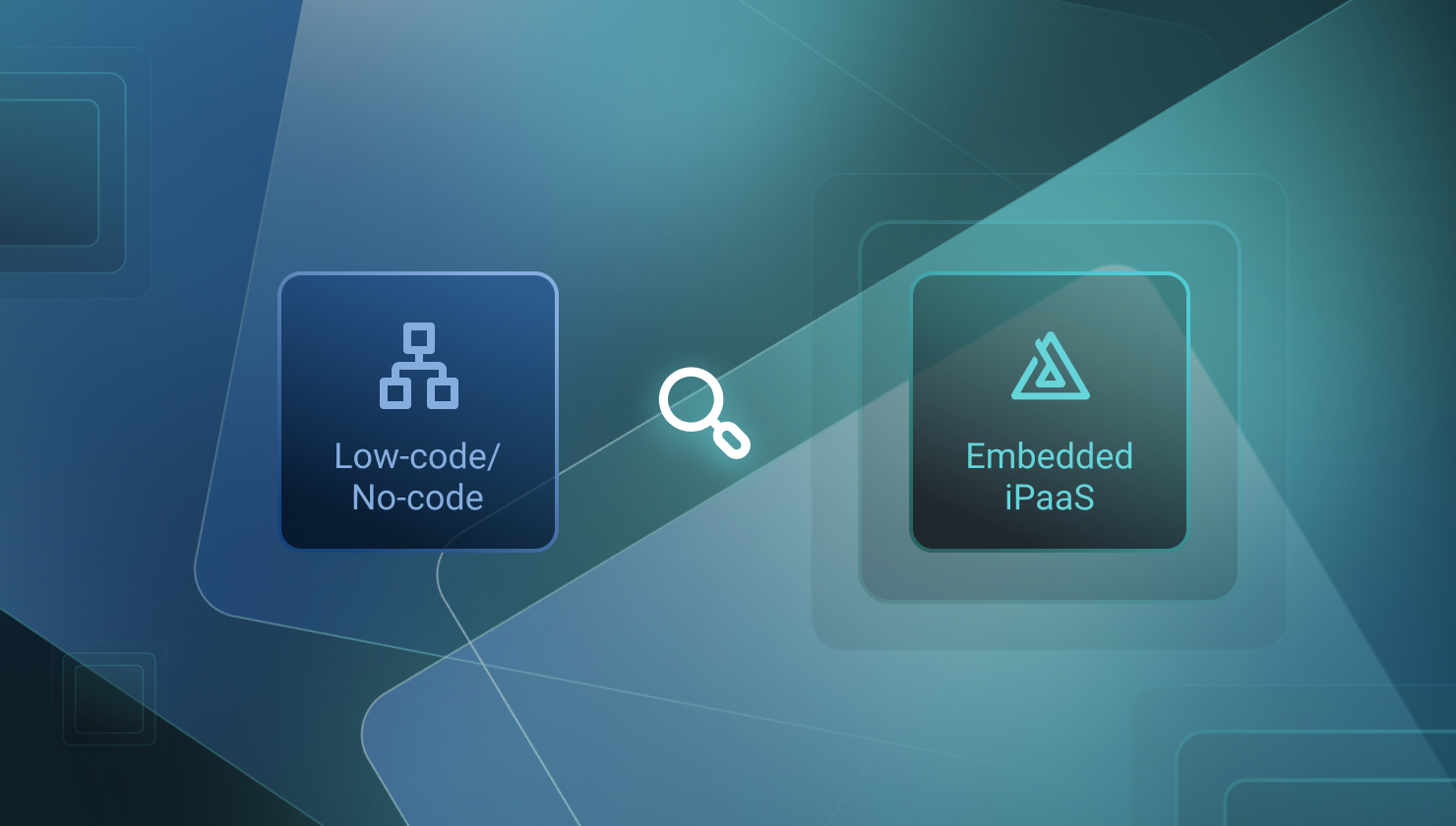Your biggest SaaS customer just demanded an integration with a legacy homegrown system and wants it right away. Your product team is debating the infrastructure: should you use the familiar LCNC (low-code/no-code) application platform you already use for internal needs, or should you invest in a purpose-built embedded iPaaS tailored for customer integrations?
LCNC platforms such as Mendix, Bubble, and Appian are great for rapidly delivering internal apps, but an embedded iPaaS provides the essential, purpose-built infrastructure for scalable, secure, and multi-tenant customer integrations that drive SaaS product success.
Let's consider both platforms, lay out a clear comparison, and give you the data you need to make the right decision for your scenario.
Understanding LCNC application platforms
What they are and how they help
LCNC application platforms are designed to enable rapid application development with minimal coding. Their core focus is building things with drag-and-drop UIs.
They are typically used to build internal tools, quick MVPs, business process automation, and lightweight department-specific apps.
Their strengths are:
- Fast time-to-market for apps, empowering non-devs to build apps.
- Visual, drag-and-drop builders with pre-built UI components.
- Internal workflow automation and rapid prototyping.
The integration limitation
However, LCNC platforms are not designed for productized, multi-tenant, B2B SaaS integrations at scale. Much like an enterprise iPaaS, they don't have the infrastructure needed to build, deploy, and manage customer-facing integrations.
As such, they:
- Lack functionality such as automated per-tenant deployment and isolation.
- Have limited capabilities for error handling, retry logic, and monitoring across multiple tenants.
- Introduce tech debt.
This aligns with the limitations of ETL platforms when used for integrations: ETL tools are great for batch data processing and internal data warehouses, but they are ill-suited for customer-facing integrations. LCNC platforms are great for internal apps, but they don't work as reliable, scalable B2B SaaS integration infrastructure.
Understanding embedded iPaaS
The purpose-built platform
An embedded iPaaS, like Prismatic, is purpose-built to handle everything that breaks at scale: authentication, deployment, monitoring, scaling, and security. This infrastructure layer ensures integrations are reliable and scalable by default, while providing flexible build experiences through low-code and code-native development.
As such, it includes:
- Multi-tenant deployment with instance isolation and scaling.
- Connector libraries and an SDK for building custom components.
- An integration marketplace and customer self-service dashboards.
- Enterprise-grade features such as monitoring, alerting, automated retries, version control, security, and compliance.
Prismatic includes both an integration designer (for non-devs who need to build integrations) and an embedded workflow builder (for customers who need to build integrations). Both are low-code/no-code tools with drag-and-drop UIs. In addition to these low-code/no-code tools, Prismatic provides a code-native integration-building experience for devs who need the flexibility that comes from writing integrations in their favorite IDEs.
The power of productization
The key strength of embedded iPaaS is that it offloads infrastructure and corresponding operational tasks (deployment, maintenance, etc.).
It's built to:
- Enable complex workflows, detailed business logic, and customer-specific configurations.
- Scale in the background as your customer base and integration volume grow.
- Enable product and engineering teams to focus on core product features, not integration plumbing.
When to use each platform
The choice comes down to who the integration is for (internal or external users) and whether the integration will need to scale to support many customers or just a handful.
Choose an LCNC platform when:
- You are building internal tools, admin dashboards, or low-complexity apps.
- Integration needs involve a few simple APIs that are internal or single-tenant.
- Customer self-service is not required.
- The integration doesn't need to scale to a large number of customers.
Choose an embedded iPaaS when:
- You are delivering integrations as SaaS product features for many customers.
- You require multi-tenant, scalable deployment with customer-specific configurations.
- You have detailed monitoring, error handling, and security/compliance requirements.
- You need productized integrations with a marketplace.
- You are handling complex, multi-flow integrations.
- You need customers to be able to build their own one-off workflows.
Questions for your team
Before making a decision, your team should first address these critical questions.
- How many customers will ultimately use these integrations?
- Will customers need self-service configuration and monitoring?
- How complex will the business and technical logic be?
- Will integrations differentiate your product and drive revenue?
Choose the platform that works best for you
LCNC platforms are excellent for rapid internal application delivery, but they are inherently limited when used for scalable, multi-tenant customer integrations. They are app builders and not integration infrastructure.
Embedded iPaaS provides the purpose-built, scalable integration infrastructure critical for SaaS products that require security, reliability, and customer self-service.
Request a demo, and we'll help you assess your integration strategy and determine whether an embedded iPaaS is the right platform to deliver the integrations your customers need.




